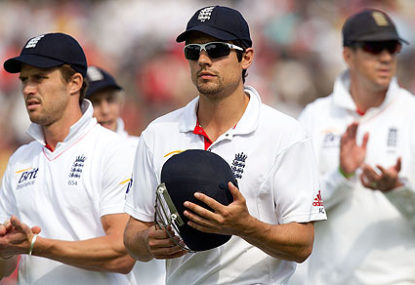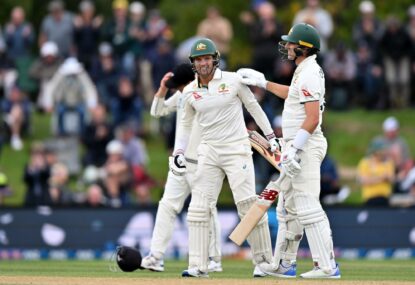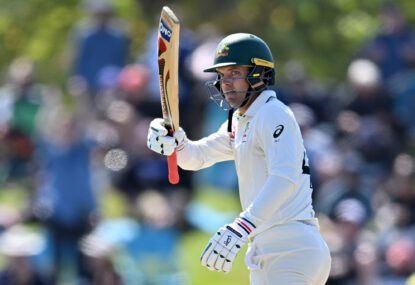For only the 14th time in cricket history a Test side, in this case New Zealand, has managed to score in excess of 500 runs in the first innings and lose the match.
After dominating the Lord’s Test for long periods, including having England 4-31 on the first morning, then batting their way to a 134-run first innings lead, New Zealand supporters will be left wondering how this translated into a 124-run loss, with 10 overs remaining on the final day.
The short answer lies in a combination of New Zealand’s inability to sustain pressure with the ball and strong individual performances by a number of English players to resist, and then ultimately overcome, what the Black Caps offered.
England cricket in recent times has lurched from crisis to crisis, including a weak performance at the World Cup, a disappointing drawn series in the West Indies, fall-out from the non-selection of Kevin Pietersen, and the sacking of coach Peter Moores.
However despite all of this, they seemed better prepared for Test cricket than their opponent, and they ultimately provided more players in the match who performed at their highest level.
And now, with a win under their belt, which seemed unlikely if not impossible midway through this Test, and the announcement of Trevor Bayliss as their new coach, one can sense a momentum shift as huge as it is sudden.
Whether the problems which underpin English cricket are as simply solved as a result may be debatable, but nobody can deny their giant strides in the right direction.
Ironically it was a New Zealander, at least by birth, in Ben Stokes, who provided the greatest impetus. Despite significant contributions from skipper Alastair Cook, skipper in waiting Joe Root, and a sharp Stuart Broad, it was Stokes who took the initiative. He matched Brendon McCullum’s aggressive intent and then raised it some more, and ultimately swung the match England’s way.
We had seen a window to this when Stokes enjoyed a solid Ashes series, near the top of both England’s batting and bowling aggregates. This included a belligerent maiden Test century, 124 in the third Test in Perth.
With Alastair Cook methodically whittling away the first innings deficit, Stokes upped the ante by blasting 101 off only 80 balls, including a full-blooded assault on Tim Southee. Not only did this wrest the psychological advantage away from New Zealand, the speed of the attack also provided England with sufficient time to turn their minds from a possible draw to a possible win.
With victory being secured with only 10 overs remaining, this ultimately proved to be the match-defining move.
For New Zealand’s part, McCullum seemed happy with his team’s effort and does not look like backing down from his aggressive style any time soon. But he may well pause to ponder that while overt aggression works very well against sides which either don’t expect it, or are not equipped to counter it, it is another matter altogether when fire is returned with fire.
His demeanour at the post-match presser certainly indicated that his side was still going for the win on the final day, even right up to the point of Corey Anderson’s dismissal, despite having lost both openers without any score on the board.
If McCullum doesn’t rate a draw as a result and would rather lose trying for a win, then that is his right, however I expect that most New Zealand supporters would have been happy to see all of their batsmen take stock of the situation, apply themselves to securing the draw, and then roll the dice again at Headingley from a position of 0-0 in the series.
It was only the ever-reliable BJ Watling, still hampered by a Day 1 knee injury, who really gave the impression that he was prepared to bat out the whole day.
That they were in this position at all was, England’s fighting qualities aside, disappointing enough. Conditions for bowling remained excellent throughout the Test, with seam and sideways movement always present in varying degrees, and turn available as well.
The New Zealand pace attack seemed to lack venom and stamina – certainly by comparison to England – and Southee in particular fell away badly in the second innings. Bowling, which had been so disciplined at the start of the Test, full and accurate, gave way to short-pitched rubbish which held no fears at all for Stokes.
Mark Craig too will be disappointed with his contribution. While he looked dangerous for the most part, he did not manage to bowl sufficiently tightly to place any real pressure on the England batsmen.
If one were to split hairs, questions could also be asked about the New Zealand batting order in the second innings. Certainly Tom Latham was required to do a huge job as stand-in wicketkeeper and so may have been excused a tired shot to open the innings, and it is hard to see what McCullum achieved by pushing himself down the order.
Looking towards the second Test, starting on Friday in Leeds, there is every expectation for another cracking match. Although lacking the full package, by no means did New Zealand perform poorly in this Test. They will be better for the run and McCullum has already indicated that his policy of all-out attack will continue.
With England buoyed by the win, and the blast of confidence which will now permeate from the likes of Broad and Stokes into the rest of the team, they will certainly not want to surrender any of the initiative to New Zealand.
Which means that, weather and pitch allowing, there should be very little prospect of a draw. Which once again will make for compelling viewing.



































































































